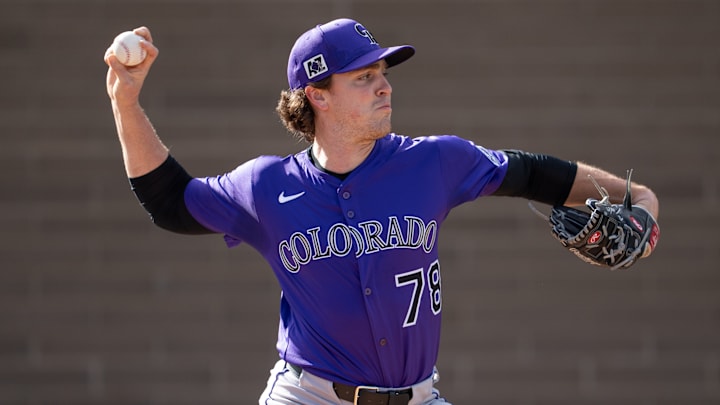For what has felt like forever, the Colorado Rockies have had little to offer when it comes to providing excitement in the pitching department.
They have long been under the "Coors" curse as their home ballpark has consistently been the friendliest ballpark for hitters to hit in. While Colorado's pitching woes can be attributed to the less than desirable conditions for hurlers in the Mile High City, they also have not done their part in developing a true ace to build a starting rotation around.
However, that narrative might start trending in the opposite direction after this weekend.
Chase Dollander's journey to the Colorado Rockies
On Friday afternoon, Rockies fans received the news that their token prospect, Chase Dollander, would be taking the mound in the big leagues for the first time in his career. This didn't come as much of a surprise, as Dollander was on a clear-cut path to Denver, although his call-up did come a bit ahead of schedule.
Dollander was one of the top pitchers in the 2023 draft class and was selected ninth overall by the Rockies out of the University of Tennessee. The only two pitchers selected before him were Paul Skenes and Rhett Lowder, both of whom have already made their big league debuts, so Dollander has done a good job of keeping pace with the elite arms of his class.
Dollander was a fast mover through Colorado's system. He didn't pitch at all following the draft in 2023, but bypassed the lower levels of the minors in 2024, making his professional debut in High-A Spokane.
He made 14 starts with Spokane and posted a 2.83 ERA over 70 innings with a 37.0% strikeout rate. Minimum 50 innings, his 37.0 K% was the highest K% among all pitchers at High-A last year.
Dollander would then earn a promotion to Double-A Hartford, where his success continued. He made nine starts and delivered 48 innings, posting a 2.25 ERA. His final line on the season between High-A and Double-A was 23 GS, 118.0 IP, 2.59 ERA, 2.92 FIP, 1.19 WHIP, 24.4 K-BB%. His performance earned him a Futures Game selection at last-year's All-Star weekend as well as first-team Minor League Baseball honors by Baseball America.
Dollander was given a non-roster invite to Colorado's MLB spring training where he had the chance to compete against some big league talent and prove to the Rockies that he was ready for his final call-up.
He made six starts and pitched 17.2 innings, and while the 7.13 ERA tells one story, his 29.6 K% showed he has what it takes to get big league hitters out. Dollander was sent to Triple-A Albuquerque following spring training where he made just one start before receiving the news that he was now an MLB pitcher.
Bah God, that’s Chase Dollander’s Music pic.twitter.com/3XyLU9YtoT
— Colorado Rockies (@Rockies) April 4, 2025
What to expect from Chase Dollander in MLB
Because of his elite tools as a starting pitcher, Dollander has what it takes to be the the Rockies' foremost front line starter, but it will take time for him to settle in to the role. Pitching at Coors Field certainly brings problems of its own that the 23-year-old right-hander will have to navigate.
Dollander possesses one of the more advanced pitch arsenals among any pitching prospect, featuring a four-seam fastball, changeup, cutter, curveball, and a slider.
Chase Dollander (@Rockies) dazzles in his Triple-A debut ✨
— MLB Pipeline (@MLBPipeline) March 30, 2025
MLB's No. 25 prospect fans five in four one-run innings for the @ABQTopes. pic.twitter.com/RSCfDbcdAk
His fastball has been regarded as one of the best in the game as he averages 97 mph on the offering with plenty of vertical ("rise") and horizontal ("run") break that gets in on the hands of right handed hitter very quick. Pitch metrics tend to trend downwards in Coors Field due to the thin air, but Dollander's velocity and command of the pitch should help it to play up despite the circumstances.
He throws his changeup, cutter, and curveball anywhere between 10% and 20% of the time, which leaves hitters having to guess what secondary pitch is coming following the fastball. The changeup is an excellent pitch against left-handed hitters while the cutter is a solid platoon-neutral option. The curveball offers another swing-and-miss option at a lower velocity while the slider is a pitch he flashes from time to time that bridges between the curveball and cutter very well.
When it comes to workload, it's likely the Rockies will be conservative with Dollander. Pitchers are spending less and less time in Triple-A nowadays because teams don't want to "waste too many bullets" in pitchers' arms before they debut.
That's likely why he only made one start at Triple-A before receiving the call-up. He averaged five innings per start last year, so it's likely the Rockies have him work in the three to four inning range, ramping him up into a six or seven inning pitcher, given he's showing he has what it takes to stick around three times through an order. It's important he adjusts to the big league workload.
Dollander will be going up against the Athletics on Sunday in Denver, which is not an easy group to pitch against this year. He'll be tested with some tough at-bats from sluggers like Brent Rooker, Lawrence Butler, and Shea Langeliers. It certainly should give the Rockies and their fans a good grasp on what they can expect from their top prospect moving forward.
